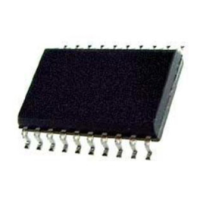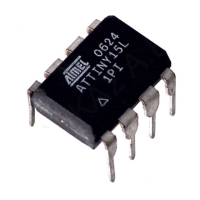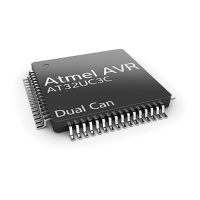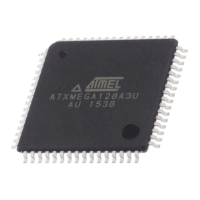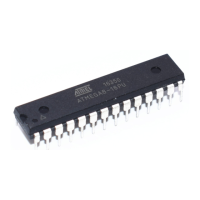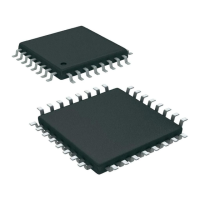77
7679H–CAN–08/08
AT90CAN32/64/128
MOSI, SPI Master Data output, Slave Data input for SPI channel. When the SPI is enabled as a
slave, this pin is configured as an input regardless of the setting of DDB2. When the SPI is
enabled as a master, the data direction of this pin is controlled by DDB2. When the pin is forced
to be an input, the pull-up can still be controlled by the PORTB2 bit.
• SCK – Port B, Bit 1
SCK, Master Clock output, Slave Clock input pin for SPI channel. When the SPI is enabled as a
slave, this pin is configured as an input regardless of the setting of DDB1. When the SPI is
enabled as a master, the data direction of this pin is controlled by DDB1. When the pin is forced
to be an input, the pull-up can still be controlled by the PORTB1 bit.
•SS
– Port B, Bit 0
SS
, Slave Port Select input. When the SPI is enabled as a slave, this pin is configured as an
input regardless of the setting of DDB0. As a slave, the SPI is activated when this pin is driven
low. When the SPI is enabled as a master, the data direction of this pin is controlled by DDB0.
When the pin is forced to be an input, the pull-up can still be controlled by the PORTB0 bit.
Table 9-7 and Table 9-8 relate the alternate functions of Port B to the overriding signals shown
in Figure 9-5 on page 72. SPI MSTR INPUT and SPI SLAVE OUTPUT constitute the MISO sig-
nal, while MOSI is divided into SPI MSTR OUTPUT and SPI SLAVE INPUT.
Table 9-7 and Table 9-8 relates the alternate functions of Port B to the overriding signals shown
in Figure 9-5 on page 72.
Note: 1. See “Output Compare Modulator - OCM” on page 165 for details.
Table 9-7. Overriding Signals for Alternate Functions in PB7..PB4
Signal Name PB7/OC0A/OC1C PB6/OC1B PB5/OC1A PB4/OC2A
PUOE 0 0 0 0
PUOV 0 0 0 0
DDOE 0 0 0 0
DDOV 0 0 0 0
PVOE
OC0A/OC1C
ENABLE
(1)
OC1B ENABLE OC1A ENABLE OC2A ENABLE
PVOV OC0A/OC1C
(1)
OC1B OC1A OC2A
PTOE 0 0 0 0
DIEOE 0 0 0 0
DIEOV 0 0 0 0
DI – – – –
AIO – – – –

